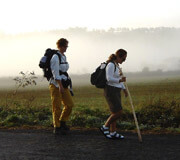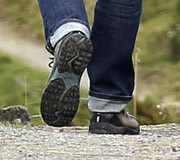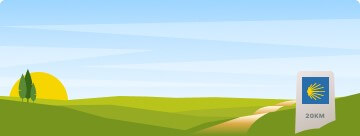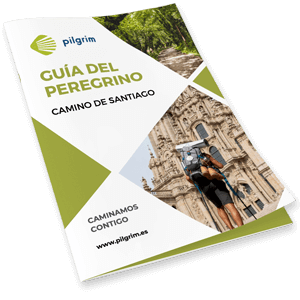How to get to the starting points of each route
- Home
- ❯
- Plan your way
- ❯
- How to get to the starting points of each route
Saint Jean Pied de Port
To get to this French city the best option is coming from Pamplona. You can get to Pamplona by plane, public transport or private car. Once you get to Pamplona you should take the N-153 to Saint Jean Pied de Port without leaving this road; also called D-933 You can also get there by bus thanks to Conda Bus Company. You can also get to Saint Jean Pied de Port coming from San Sebastián, San Juan de la Luz and using the GI-120 up to its link with the AP-8 (also known as A-63). Then you should go through D-918 and, finally, you will arrive there.
Roncesvalles
It is the second most used starting point in the French Way because most people want to avoid the previous stage. To get to Roncesvalles you should use the N-135, this road links France and Pamplona. If you want to go by public transport you can go by bus (Arteida Company) that links Roncesvalles and Pamplona every day, except Sundays and Holy Days. In summer, when there are more pilgrims, there are more buses and more bus frequency.
Pamplona
It is another place where you can start the way. There are many possibilities to get here, through AP-15 from San Sebastián, through N-111 from Logroño or through N-240 from Jaca. N-240 also takes you there from Vitoria, Galicia, and also from Madrid. If you are coming from France you can use roads N-121, N-138 and N-135.
You can also get there by train or bus. By bus from: Alicante, Barcelona, Bilbao, Salou, Peñíscola, Gijón, Oviedo, Jaca, Irún, Jaén, Logroño, Madrid, Santander, Soria, Vigo, Zaragoza and also from many Andalusia cities. You can get to Pamplona by train from Alicante, Barcelona, Burgos, A Coruña, Irún, Hendaya, Lugo, Madrid, Ourense, Oviedo, Palencia or Vitoria.
You can also get to Pamplona by plane, located 6 kilometers (4 miles) from the city center; once you arrive you can take the bus.
Pedrafita de O Cebreiro
It is the entrance of the French Way in Galicia and one of the favorite places to start the way.
You can get to O Cebreiro coming through the A-6 or the N-6. If you are traveling in a public transport, you can get there by Alsa bus that links O Cebreiro with Madrid, Barcelona, Bilbao, Lugo, Santiago and other cities. You can get there using a González de la Riva bus from Lugo and Ponferrada. Once in Piedrafita you should walk to O Cebreiro, approximately 4 kilometers (3 miles); you can also take a taxi that will cost you approximately 10 euros.
Sarria
It is a common starting point, from here you have just 100 kilometers (62 miles) to get to Santiago de Compostela.
You can get to Sarria through the A-6, taking the exit number 488 and then going through the LU-546-Sarria. If you want to use public transport you can go from Madrid, A Coruña, Barcelona, Lugo, etc. There are lots of buses that go to Santiago and Lugo that stop in Sarria.
Lisboa
The Portuguese capital is the place chosen by many pilgrims to start their way to St. James.
Most people get there by highway AP-9 or A-1. You can also get there through A-2, A-8, A-10, A-33, A-12, A-37, A-5 or A-16. The best way of getting there is through the E-1. If you are coming from Madrid you should use the A-45 and then A-5 and EX-1 to Extremadura. Once you get there you should take EX-108 and A-23 in Castelo Blanco, where we should go through the N-239 up to the A-23. Finally, we should get out in the A-1 and then take the second exit of the E-1.
Al tratarse de una gran ciudad, también se encuentra bien comunicada gracias a su aeropuerto, al que llegan compañías de bajo coste como Ryanair, Vueling o Easyjet. Una vez en él podremos desplazarnos hasta el centro de la ciudad en alguna de las líneas de autobuses que existen con tal fin.
También existe la posibilidad de llegar a Lisboa en tren, cogiendo el AVE o el Trenhotel Lusitania desde Madrid. En autobús podremos partir desde ciudades como Madrid, Barcelona, Sevilla, Bilbao y Valencia, entre otras, gracias a compañías como Alsa, Eurolines, Autna o Goeuro.
Tui
It is located on the border between Galicia and Portugal. This is why lots of pilgrims decide to start there. There are 107 kilometers (67 miles) to Santiago de Compostela, so you can get Compostela once you arrive at Santiago.
The main way of getting to Tui is using the A-55 and the A-52. Then you can use AP-9, it crosses most part of Galicia.
You can also use public transport. The name of the stop is Tui and get there coming from Porto and Vigo. You can also get there from Pontevedra, O Porriño, A Guarda, Vigo, Santiago and many different places in Portugal.
Irún
It is the official starting point of the Northern Way and where most pilgrims start their way to Santiago de Compostela.
If you want to get there by car, you can use many different roads such as the GI-636, GI-20 and the AP-8 that links all Northern Spain. If you want to use public transport you have to know that this city is well communicated with many cities such as Madrid, Barcelona, Lisbon, San Sebastián, Vitoria, Bilbao, etc. You can also get to Irún by bus. There are lots of bus companies that get to this city from some Spanish cities but also from abroad.
If you want to get there by plain, San Sebastián airport is located 5 kilometers (3 miles) from Irún. There are regular flights from Madrid and Barcelona many times a day, and also from Málaga and Palama de Mallorca in summer.
Ribadeo
This will be the entrance to Galicia if you are doing the Northern Way. It is a village located next to Asturias. There are lots of pilgrims that decide to start their way there because is located more than 100 kilometers (62 miles) from Santiago de Compostela, so you will get Compostela.
If you want to get to Ribadeo by private car you can use the A-8 that crosses most part of Lugo and Northern Spain. In the A-8 you can get the A-6, which is a dual carriageway that links A Coruña and Madrid. If you are using a national road you can get there by using the N-642 and the N-640, both roads go through many places before getting to Lugo.
Public transport is also a good option. There is a bus station in the city where Alsa and Arriva bus companies get very frequently from different cities of Spain. And there are also many buses that get there from different Galician cities. Ribadeo does not have a train station but the train Ferrol-Gijón stops there, so Lugo, Asturias and the Basque Country are well communicated.
Oviedo
It is located 300 kilometers (186 miles) from Santiago de Compostela. It is where the Primitive Way begins, the oldest way.
If you want to get there you can use one of the multiple roads that get to this city, such as A-63 that links Oviedo and La Espina; A-66 that links Oviedo with Seville; A-64 that links Oviedo with Villaviciosa or the AS-II that links Oviedo and Gijón. Other national roads that you can use to get to Oviedo are: N-630, N-634, AS-232, As-242 and the AS-266.
If you want to get there using public transport you have to know that Oviedo is well-communicated thanks to its three train stations that link the city with Madrid, Barcelona, Alicante, Ferrol, León, Santander, etc. You can also get there by bus because it has a bus station where you can take many buses to many international destinations such as Belgium, France, United Kingdom and Switzerland.
A Fonsagrada
This is another starting point of the Northern Way. It is located 150 kilometers (93 miles) from Santiago de Compostela.
The best option to get there by road is using the LU-630 that goes in parallel line with the St. James’ Way. If you want to get there using public transport you can take a bus that goes from Lugo to A Fonsagrada (Her-Vei company).
Ferrol
It is where the main port of The Royal Spanish Navy is located since the 18 century. It is the perfect place to start the English Way.
You can get there mainly using the AP-9 because it links this city with other cities in Galicia. It is also linked to As Pontes thanks to the AG-64 and Vilalba thanks to the N-651.
If you want to use public transport you have to know that it is a city that is well communicated with other cities thanks to its bus station. You can get to Ferrol coming from A Coruña, Santiago, Pontevedra, Fisterra, Ourense, Vigo, Madrid, Gijón, Bilbao, Ponferrada, Astorga, Zamora, Salamanca, Seville, etc. You can also get there from Portugal, Germany, Belgium and Switzerland thanks to Arriva, Alsa and Castromil-Monbus bus companies. There is also a train station that links the city with other cities such as Bilbao, Madrid, Barcelona, A Coruña, Santiago, Pontevedra, Vigo, Madrid, Barcelona, etc.
If you want to get there by plane, you have to know that the nearest airport is Alvedro, A Coruña airport that is located 45 kilometers (28 miles) from here. You can take a bus to come from the airport to Ferrol.
A Coruña
It is another place where you can begin the English Way, but it is not the official way. The easiest way of getting to this city is by road, using the AP-9 that links the city with other Galician cities, and also the A-6 than links this city with Madrid. You can also use many secondary roads such as the N-Vi and the N-550 that has the same route as the AP-9 and the A-6. The train station links the city with Barcelona, Madrid, Bilbao, Vigo, Ferrol, Monforte de Lemos and Ourense.
The bus station has a lot of different bus companies that would allow you to get here from many cities such as Santiago de Compostela, Vigo, Pontevedra, Ourense, Fisterra, Lugo, Ferol, León, Madrid, Salamanca, Asturias, Cádiz, Algeciras and other cities.
It also has an airport that is located 10 kilometers (6 miles) from the city center. You can get here coming from London, Paris, Madrid, Barcelona, Seville, Bilbao, Zaragoza, Valencia, Lisbon, Amsterdam or the Canary Islands.
Seville
There are approximately 1,000 kilometers (621 miles) between Seville and Santiago de Compostela. It is one of the main cities in Spain, so there are many ways to get there.
The easiest way to get to Seville is using the roads E-5 and the AP-4 this highway links Dos Hermanas with Puerto Real. You can also use the A-4 that links this city with Madrid. The A-66 links Seville and Gijón. The A-1 and A-49 get to this city from Portugal; and the A-92 links this city with Almería.
If you want to get there by public transport you can use the bus that comes from Madrid, Barcelona, Valencia, Bilbao, etc. But you also have the option of coming by train or AVE (high-speed passenger train) that has lots of routes to this city.
El aeropuerto de Sevilla se encuentra a un cuarto de hora del centro de la ciudad, existiendo multitud de lanzaderas que nos pueden llevar al centro. Al tratarse de uno de los aeropuertos más transitados de la comunidad, son muchas las compañías que operan aquí, destacando la presencia de rutas entre Alicante, Almería, Bilbao, Barcelona, Gran Canaria, Lanzarote, Madrid, Palma de Mallorca, Santander, Santiago de Compostela, Tenerife, Valencia y Zaragoza, entre otras.
Granja de Moreruela
This small village of Zamora is where Vía de la Plata divides into two different ways, you can go through Tábara or through the Sanabrés Way.
You can get there thanks to the N-630 and also take any of the bus routes that get there coming from Zamora and Benavente.
The official starting point of this way is Granja de Moreruela that is a village where Vía de la Plata goes through. You can also start this way in:
A Gudiña
It is located 200 kilometers (124 miles) from Santiago de Compostela. You can get there thanks to the A-52 taking the exit number 124 or 129. Other roads that go through this village are the N-525 and the OU-533, both get to the center of the village.
If we want to use public transport you can get there using the train that comes from places such as Puebla de Sanabria, Medina del Campo, Segovia, Ávila, Madrid, Ourense, Santiago de Compostela, Pontevedra, Salamanca, Valladolid, and Palencia. You can also get there by bus thanks to Avanza Bus Company that comes from Madrid or Vibsa Bus Company that comes from Vigo, Barcelona and Irún. A company called Anpian offers two routes that come from France (Paris and Tours).
Verín
It is a famous village due to its Carnival. You can get to this city thanks to the A-52. You can also come from Ourense using the OU-1014 or the N-525, both of them go through the center of the village. Another option is traveling using the public transport, there are lots of bus companies that offer a way to get there from Madrid, Ourense or Salamanca.
Ponferrada
This city is deeply linked with the St. James’ Way since the Middle Ages. The Winter Way starts there, going through it pilgrims avoid O Cebreiro, a hard stage in winter.
The main way of getting there is using the A-6 that links A Coruña and Madrid getting out in the 382 or 388 exit. If you want to use the public transport there are a bus station and a train station, both are well connected with León, Galicia and other Spanish cities.
León’s airport is located two hours from Ponferrada and then you can take a bus or the train to get to Ponferrada. Monforte de Lemos
Monforte de Lemos
This is the other place where you can start the Winter Way. There are approximately 110 kilometers (68 miles) between Monforte and Santiago. The main road to get there is the A-52 getting out in Ourense. You can also use the A-6 and many secondary roads.
If you want to get there using the public transport you have to know that there are many companies such as Vibasa and Alsa that get there coming from many places in Spain such as Santiago, Lugo, Ourense or O Barco de Valdeorras.
Fisterra
It is the second most visited place in Galicia, just after Santiago de Compostela. You can get here coming from Santiago or A Coruña. There are five daily buses that come to this village this amount increase on the weekends and also in summer, so more people can get there.
Muxía
This is another important place related to St. James because the apostle stay here when he was alive. To get there the best option is coming from Santiago or A Coruña. You can take a bus, there are many bus companies that have buses coming to this village, such as Autocares Vázquez or Ferrín.



